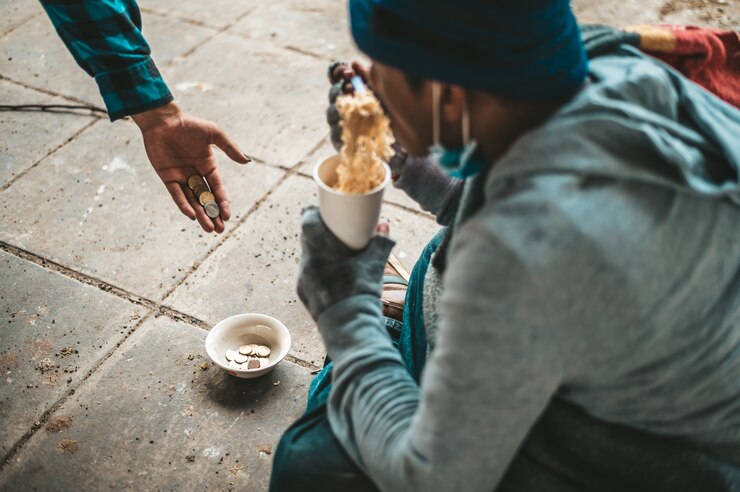Abstract
South Africa provides food parcels to those in need with social grants to alleviate hunger and poverty. However, the quality and quantity of the food provided to those in police custody is superior to those receiving social grants. The government’s priorities can be observed through its allocation of resources, which ultimately determine how funds are distributed. Detainees receive three well-balanced meals each day, while individuals who rely on social grants struggle to put food on their tables even once. The government actively ensures that prisoners receive sufficient nutrition while in custody thereby contributing to their comfort and safety, in total disregard of the possible motives of the suspect. Should the suspects in police custody receive better treatment from government than innocent people who live above suspicion their entire lives?
Introduction
In South Africa, the government’s priorities and allocation of resources have been the subject of intense scrutiny and debate. Hunger and food security have long been significant concerns in the country. To address this issue, the government has implemented various feeding programs, particularly through the provision of social grant food parcels.
As of 2023, a South African with a monthly income of less than R 1,058 South African rand is considered as poor. Moreover, individuals with only R 760 South African rand per month for food were living below the poverty line according to national standards.
The South African Social Security Agency (SASSA) provides an average grant of little more than R 2000 per month to those in need. For this discussion, we will exclude other grants such as the old age child grant, Social Relief of Distress Grant, and others.
Social grant recipients in South Africa have long struggled to make ends meet, with many unable to afford necessities such as food. They must rely on the limited resources available to them, often resulting in inadequate meals.
These grants aim to alleviate poverty and meet basic needs such as food, education, and healthcare. However, the adequacy of these grants remains a topic of debate. Social assistance food packages play a vital role in the government’s endeavors to alleviate hunger and poverty. Eligible individuals who receive social grants, including the elderly, persons with disabilities, and children from vulnerable households receive these parcels. The primary objective of this feeding program is to provide essential nutritional support to those in need, thereby ensuring their access to basic food items. Larger families may face challenges in adequately feeding everyone with the food provided in these packages.
Food Prices
According to reports, the prices of essential staple foods, which are prioritized in households and by the purse, have remained persistently high. These foods are purchased to ensure that families do not go hungry and can prepare meals, even during load-shedding interruptions.
A standard food basket typically consists of 17 staple foods, such as maize meal, rice, cake flour, white sugar, sugar beans, Samp, cooking oil, salt, potatoes, onions, frozen chicken portions, curry powder, stock cubes, soup, tea, and both brown and white bread. In August, the cost of these food items amounted to R2,826.37 in an average household basket, leaving limited room for more nutritious foods like eggs, meat, and vegetables.
The average cost of a household food basket increased significantly to R 5,124.34 in August 2023.
While social grants serve as a lifeline for many South Africans living in poverty, there are lingering concerns about their adequacy. These grants aim to assist individuals in meeting their basic needs, including food.
Crime for Food
Before 1994 every police station had someone appointed to supply and prepare meals for the suspects in detention. Larger police stations employed a “matron” for this purpose. An officer’s wife performed the job at smaller police stations. Maize meal porridge, Samp, bread, jam, and black coffee were the staple. In the matron’s absence (weekends and holidays) the policemen on duty were responsible for preparing and serving the meals. More about the matrons can be read at link 1 and link 2.
Interestingly, the quality of food available to people in police custody is far superior to what those receiving social grants can afford. These individuals receive three nutritious meals per day. The meals meet their dietary requirements, incorporating a variety of essential components such as fruits, vegetables, proteins, and grains. Menu items includes jam, syrup, macaroni, chicken, mince, fish, fruits, and vegetables. The meals provided to individuals in police custody are carefully balanced to promote their well-being during their time of incarceration. The serving per person in detention closely resembles the figure of the average food basket at R 5,124.34 per month.
While prisoners benefit from nutritious meals, many individuals are dependent on social grants struggle to provide themselves and their families with adequate food. The food parcels provided to social grant recipients may be lacking in nutritional value and variety, often lacking fresh produce and protein sources. While both social grant food parcels and inmate meals in South Africa aim to address concerns regarding food security, there are notable disparities in the quality and quantity of the food provided, benefitting those under suspicion of being involved in committing crimes.
The significant difference in the provision of meals raises concerns about the government’s commitment to upholding human rights and ensuring fair treatment for all individuals, regardless of their legal status. It is important to remember that suspects are presumed innocent until proven guilty, and their treatment should reflect this principle.
A most important notion of this disparity is that homeless people who receive SASSA grants are better off by committing petty crimes. During their incarceration suspects will receive 3 nutritious meals for every day of incarceration and be rested until their release back into the harsh environment of social dependency. This lifestyle may become a spiral of anti-social behavior to survive the consequences of hunger.
Conclusion
This raises questions about the government’s dedication to eradicating poverty and addressing inequality. The stark contrast between the quality of meals provided to prisoners and the hardships faced by those collecting social grants in South Africa is a clear indication of a systemic inequality.
This prompts to question the government’s priorities and the fairness of the existing system. The government’s priorities can be observed through its allocation of resources, which ultimately determine how funds are distributed. Prisoners receive three well-balanced meals each day, while individuals who rely on social grants struggle to put food on their tables even once. The government actively ensures that prisoners receive sufficient nutrition while in custody thereby contributing to their comfort and safety, in total disregard of the possible motives of the suspect.
Should the suspects in police custody receive better treatment from government than innocent people who live above suspicion their entire lives?





